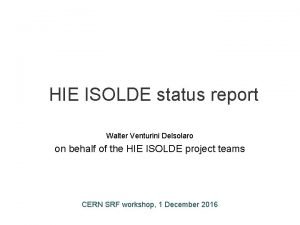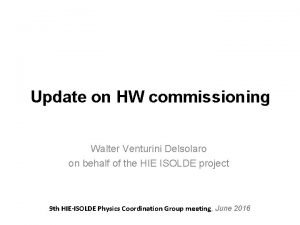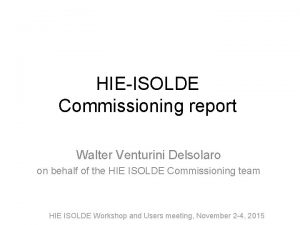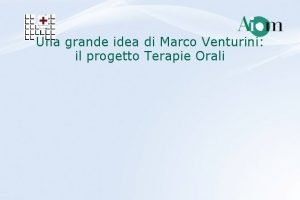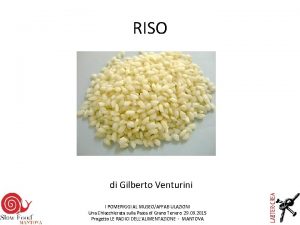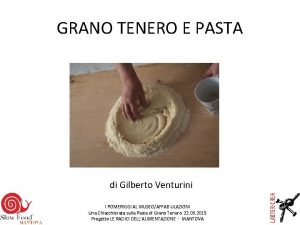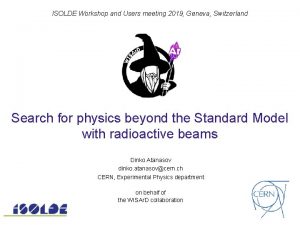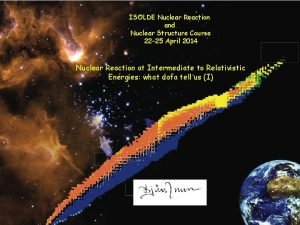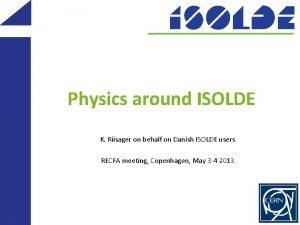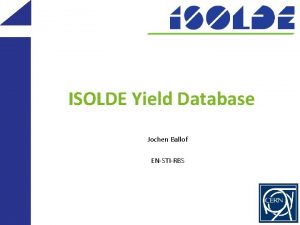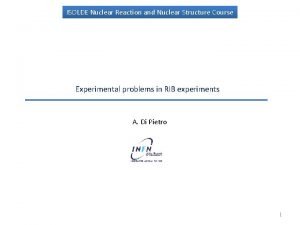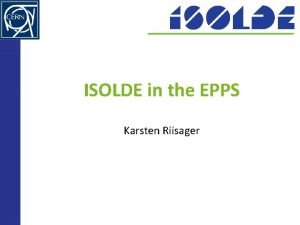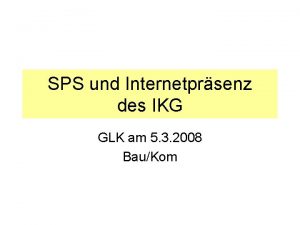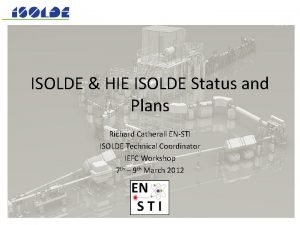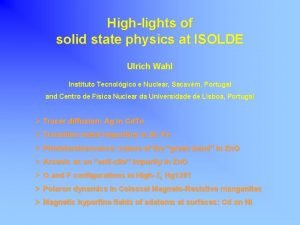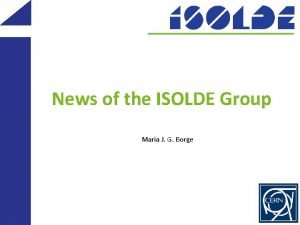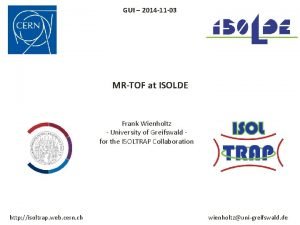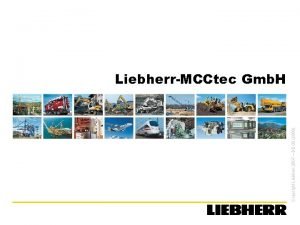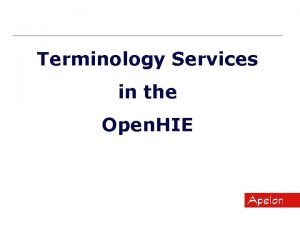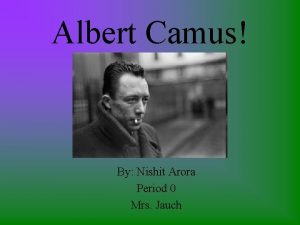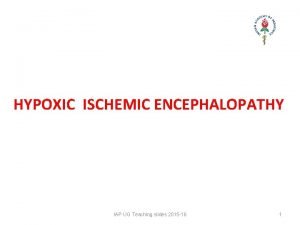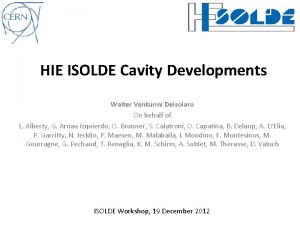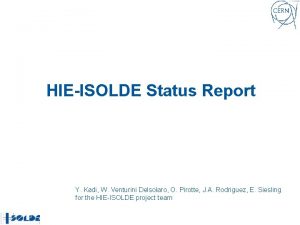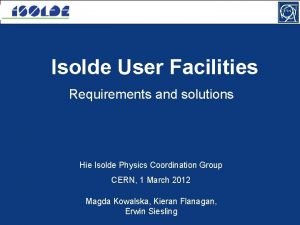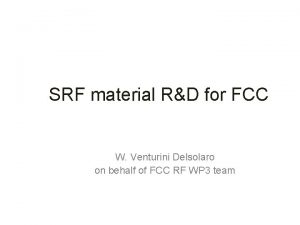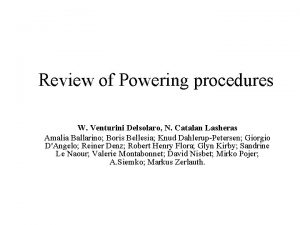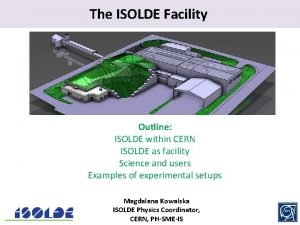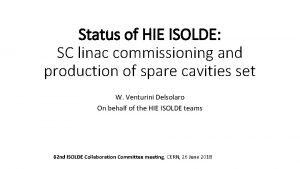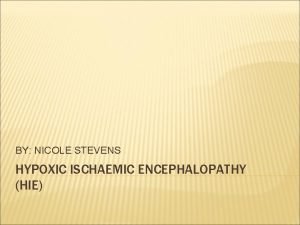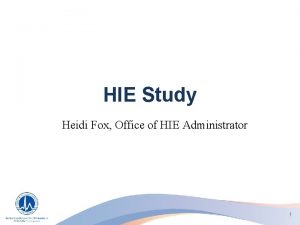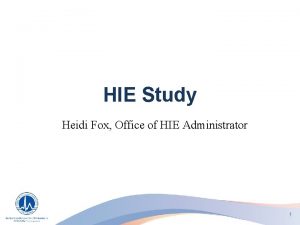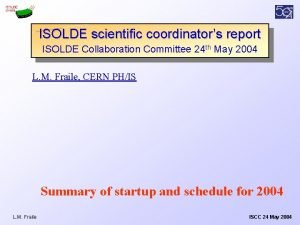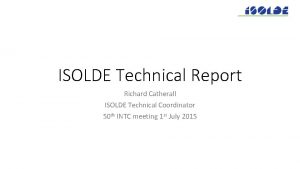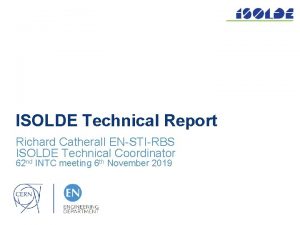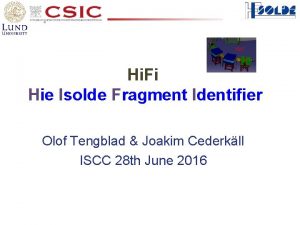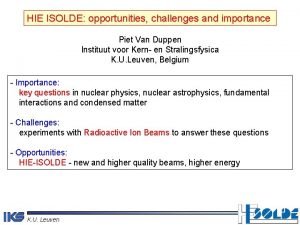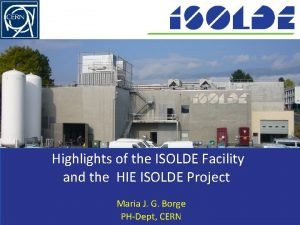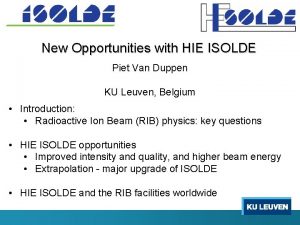HIE ISOLDE status report Walter Venturini Delsolaro on






















- Slides: 22

HIE ISOLDE status report Walter Venturini Delsolaro on behalf of the HIE ISOLDE project teams CERN SRF workshop, 1 December 2016

Outline • 2016 commissioning campaign • Superconducting RF • Cryogenics issues • • Summary of 2016 physics run Ongoing HW commissioning activities Superconducting cavities and modules for phase 2 Planning for 2017

Hardware commissioning highlights • Main NEW ISSUES identified: • • Cool down much longer than expected Difficulties to manage cryo transients Field emission in two CM 1 cavities Suspect vacuum leak in CM 2 Short circuit on CM 1 solenoid circuit SRF cavity detuning from cryo-plant ~ 100 W static heat load un-accounted for • On the good side • The new RF couplers worked well • Solenoid short to ground circumvented • Positive vacuum evolution in CM 2 • SRF settings for physics below onset of FE • Re commissioning work after the physics run: ü He processing of the two “sick” cavities • Cryogenic heat load measurements • Leak detection of CM 2 (at warm)

SRF cavity performance (July 2016)

Cause of SRF cavities detuning

Summary of 2016 physics campaign ~ 680 hours of RIBs with HIE-ISOLDE energies (+ 72 hours of stable beams at end of the physics run) ~90 hours of beam at HIE-ISOLDE energies during the whole 2015 campaign… Experiment # IS 562 IS 548 IS 557 IS 551 IS 561 IS 559 RIB 110 Sn 142 Xe 78 Zn 132 Sn 9 Li 66 Ni Energy [Me. V/u] 4. 5 4. 3 5. 5 6. 8 (7. 2 req) 4. 5 Target GPS HRS GPS Exp. Station Miniball Spect. Scattering Chamber Miniball Spect. Start date Sep. 9 th Sep. 26 th Oct. 10 th Oct. 19 th Oct. 28 th Nov. 4 th End date Sep. 18 th Oct. 2 nd Oct. 16 th Oct. 26 th Nov. 1 st Nov. 14 th Length [hours] 115 100 130 70 136

He processing in situ (November 2016)

He processing in situ (November 2016)

Cryogenics: issues and work to do ‒ Heat load and oscillations on the Cryogenic Distribution System Ongoing tests: boil-off, power tests, cooling of jumper boxes thermal shields ‒ Compressor flow capacity (addressed at next re-start) ‒ Minor hardware and controls issues (CV positioners, program corrections, naming, ranges, faceplates) Addressed during EYETS ‒ Automatic operation of cool-down, warm-up and recovery after power cut: manual operation for these modes till LS 2

Outline • 2016 Hardware Commissioning campaign • Superconducting RF • Cryogenics • • Summary of 2016 physics run Ongoing HW commissioning activities Superconducting cavities and modules for phase 2 Planning for 2017

Reminder of strategy for phase 2 cavities • Accept degraded performance for CM 3, and work to recover cryogenics margin for CM 4 • Strategy developed by the project and agreed with the concerned groups, based on 3 parallel lines of action: 1. Continue with industry production (QS) up to QS 20, and try to bring quality back on track 2. Re-internalize the last two cavities (QSC) 3. Develop a new design (seamless QWR QSS) • Presented and endorsed by ATSMB on 23. 5. 2016

Status of QS cavities • Production in RI up to QS 20: ALL CAVITIES AT CERN • After the experience with QS 13 and QS 14 (shrink fit and weld at CERN) • QS 15 was still produced without smoothening weld: it was worst substrate (lots of cracks and worst performance of all). • Rejected, it will be stripped and maybe repaired) • Welding parameters were slightly re-adjusted and smoothening weld was re-introduced for QS 16 • QS 16 was received and no apparent defects were found after SUBU • QS 16 had the best RF performance (meets specs) of the QS series • • QS 17 was received and no apparent defects were found after SUBU QS 17 coated, now under cold RF test QS 18 was damaged by RI (machining error) QS 19 and QS 20 are at CERN, the pre-tuning step is done

CM 3 cavities 70 W at nominal (5 x 6 MV/m) 50 W at 5 x 5. 2 MV/m


Status of QSC cavities • • Parts for QS 22 and QS 23 taken back from RI and shipped at CERN EN-MME producing 2 cavities, due by end 2016 Excellent progress. No quality issues and on schedule and so far Shrink-fit and weld planned for w 49

Status of seamless cavities • Full scale “prototype”, without beam ports and He flange • Tolerances met: manufacturing method demonstrated • RF design optimized and beam dynamics simulated • Order placed for 2 cavities + 1 in option • Expected delivery: end February 2017

Simplified 2017 planning

la y bl tio n m iss io ni ng Op er at io n To ta l 2 01 M ai 6 nt en an ce As se m bl In y st al la Co tio m n m iss io ni ng Op er at io n To ta l 2 01 M ai 7 nt en an ce In st al la Co tio m n m iss io ni ng Op er at io n To ta l 2 01 8 m Co al st In se m ce an en nt As ai M Phase 2 Resources FTEs Projet 2016 FTEs APT 30 25 20 15 10 5 0 2017 2018

Conclusions • • Ø • • Successful 2016 physics run after first HW commissioning: He processing in situ of HIE ISOLDE cavities demonstrated: No need to bring back CM 1 to the clean room for the time being Cryogenics tests to understand static heat loads starting Machine studies (beam measurements etc. ) to be intensified next year • The agreed strategy on cavities for phase 2 is being implemented: – – All RI cavities at CERN, being processed One RI cavity met specs after change of weld parameters Excellent progress with CERN produced cavities (QS 22 and QS 23) Seamless cavities program progressing well • CM 3 assembly finished, transport on 24 Jan. 2017 • Detailed planning for 2017 available: we keep going… • BIG THANKS TO ALL CERN GROUPS!

SPARE SLIDES

Beam commissioning highlights Minimal program before physics run + one week after it Phasing of SRF cavities using dipole and Si detector (TOF) Transmission measurements using Faraday cups Beam size measurements with scanning slits to compare with optics model • Twiss parameters measurements with quadrupole scans • Beam energy measurements with different methods (SRF cavity calibrations, bending magnets and slits, TOF) • Mainly testing methods, no time for systematic measurements Bunch time structure for beams with different energies measured at XT 00. 1000 Si detector N / NMAX • • Measured ESRF 08 Energy beta [MV/ [Me. V/u] m] E 1 5. 455 4. 908 0. 1023 dt 1 [ns] dt 2 [ns] dt 12 [ns] 2. 12 0. 00 0. 1023 4. 908 E 2 4. 455 4. 846 0. 1016 3. 64 3. 34 1. 81 0. 1015 4. 838 E 3 3. 455 4. 784 0. 1010 5. 44 6. 68 3. 34 0. 1009 4. 780 E 4 2. 455 4. 722 0. 1003 7. 15 10. 05 5. 00 0. 1003 4. 718 E 5 1. 455 4. 659 0. 0996 8. 79 13. 29 6. 62 0. 0996 4. 659 E 6 0. 455 4. 597 0. 0990 10. 56 16. 39 7. 94 0. 0991 XT 00. 1000 Si detector 4. 612 beta Energy [Me. V/u] Bunch time structure for beams with different energies measured at XT 00. 1900 Si detector N / NMAX Nominal time [ns] 7. 76 m XT 00. 1900 Si detector

Relative Energy Measurements Using Dipole: I / IMAX Energy measurements using the first dipole magnet of the XT 01 line: § Vertical slits (1 mm) were inserted before and after the dipole to select ions in the beam axis § Quads and steerers were turned off Dipole scans for beams with different energies § The gradient of the third SRF cavity of the second cryomodule was changed between 5. 5 and 0. 5 MV/m § The silicon detector in XT 01. 0400 was used to measure the beam rates for different settings of the dipole § Energy changes smaller than 0. 5 % could be resolved § Repeatability of the method was checked (E 1&E 1 b) Measured Nominal ESRF 08 Energy [MV/m] [Me. V/u] d. E / E 1 BPEAK [T] Energy [Me. V/u] E 1 5. 455 4. 908 1. 000 0. 7021 4. 908 E 2 4. 455 4. 846 0. 987 0. 6980 4. 851 E 3 3. 455 4. 784 0. 975 0. 6933 4. 786 E 4 2. 455 4. 722 0. 962 0. 6883 4. 717 E 5 1. 455 4. 659 0. 949 0. 6849 4. 670 E 6 0. 455 4. 597 0. 937 0. 6805 4. 611 E 1 b 5. 455 4. 908 1. 000 0. 7022 4. 909 B [T] 1 mm vertical slits Silicon detector All quads and steerers off Jose Alberto Rodriguez – 25 th HIE-ISOLDE Management Board – Nov. 25 th 2016
 Walter venturini
Walter venturini Walter venturini
Walter venturini Walter venturini
Walter venturini Difference between status report and progress report
Difference between status report and progress report Studio 3 marco venturini
Studio 3 marco venturini Gilberto venturini
Gilberto venturini Gilberto venturini
Gilberto venturini Isolde workshop
Isolde workshop Isolde martinson
Isolde martinson Isolde k
Isolde k Isolde yield database
Isolde yield database Reaction structure
Reaction structure @isolde
@isolde Ikg rt schulportal
Ikg rt schulportal Isolde
Isolde Isolde reveal
Isolde reveal Isolde maria johan
Isolde maria johan Isolde frank
Isolde frank Offshorekrane / bohrinselkrane
Offshorekrane / bohrinselkrane Akaims
Akaims Terminology services
Terminology services Simone hie
Simone hie Iap ug slides
Iap ug slides
